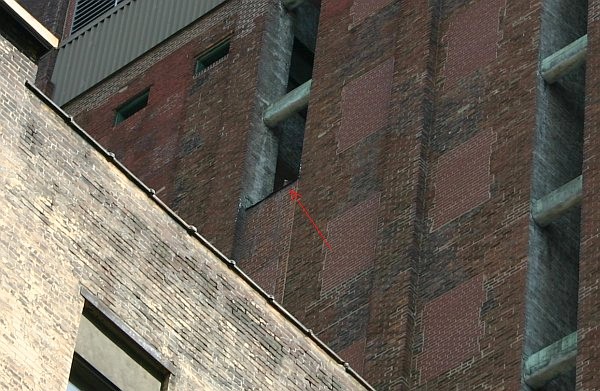 Transit of Venus tonight. Click here for a cool video describing it.
Transit of Venus tonight. Click here for a cool video describing it.
Yearly Archives: 2012
Incoming!
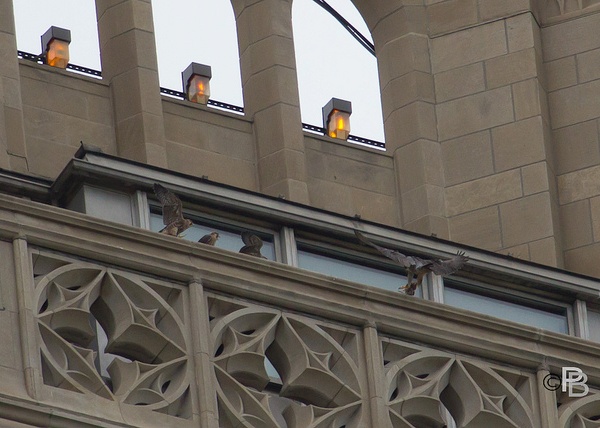
All five Pitt peregrines were visible yesterday at Fledge Watch. While their parents watched closely the chicks walked and flapped on the ledge. None of them flew … yet.
At this stage in the chicks’ development Dorothy and E2 switch off babysitting. They don’t assist the chicks in their first flight but at least one adult is present to watch for activity, track where the chick lands and reward him with a snack.
At midday Dorothy stayed at the Cathedral of Learning while E2 went hunting. Just after I left Schenley Plaza, E2 brought in a late lunch and exchanged it with Dorothy in mid-air. (Dang! I missed it.)
Here’s Dorothy delivering it to three loud, excited boys.
Incoming!
… Maybe one of them will fly today …
(photo by Peter Bell)
p.s. Fledge Watch today (Tuesday, June 5) will be from 12:30pm to 1:30pm and after work 5:30pm to (maybe as long as) 7:00pm at the Schenley Plaza tent. Click here for the schedule or follow @KStJBirdlog on Twitter or Kate StJohn on Facebook for Fledge Watch updates.
p.p.s Many people stopped by Fledge Watch yesterday. I won’t remember everyone’s name but here are a few: Kelly, David, Caleb, Anne-Marie, Peter, Sharon, Alexander, Mary, John, Paula, Christina, Amy and a colleague from the museum, many more whose names I never knew… and now my memory fails me. Thanks to all!
Two Kinds Of Crows

4 June 2012
It used to be easy to identify crows in Pittsburgh. Every crow was an American crow (Corvus brachyrhyncos). But not any more.
In recent years fish crows (Corvus ossifragus) have been expanding their range northward from the coastal Southeast. The first I’d heard of them in western Pennsylvania was in Indiana County, PA in 2008. I found this odd because Indiana County is land-locked.
What was a fish crow doing without fish? They earned their name by scavenging on beaches but fish crows aren’t picky. They’ll eat anything. They must have made an easy transition from dead fish to discarded hamburgers. Perhaps one spring they followed some American crows to western Pennsylvania … and so they are here. This year, 2012, they’ve been reported nesting in the City of Pittsburgh.
Fish crows are smaller than American crows but they’re impossible to tell apart except by voice. As Birds of North America Online says, “The only reliable difference between the two is vocal. The Fish Crow sounds like an American Crow with a bad cold.”
I’m sure you can imagine an American crow’s call without listening but here’s a recording to prepare you for the difference. “Caw, Caw, Caw.”
The fish crow’s call is two nasal syllables: “Uh-oh. Uh-oh.” (Click here to hear.)
Easy? Yes, except at this time of year. Baby American crows have nasal voices too (yikes!) so the call you hear could be a baby crow. There’s still a difference, though. Baby American crows call with a single note. (Click hear to hear.)
So, now that we have two kinds of crows, you’ll have to wait until they speak to be sure of them. “Uh oh!”
(photo of a fish crow by Chuck Tague)
Fledge Watch News
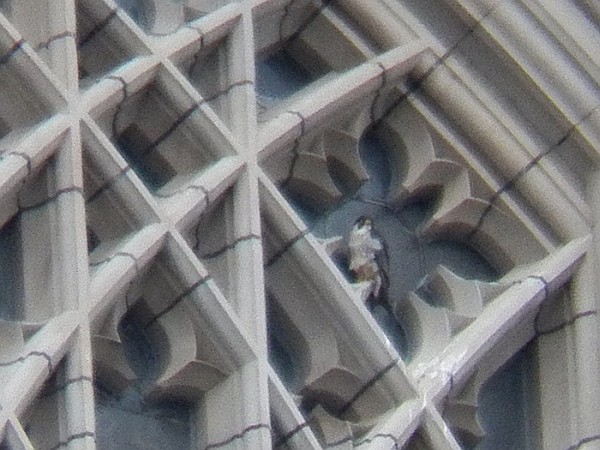
None of the chicks fledged yesterday (Sunday, June 3) but their parents put on a show. E2 perched on the south face of the Cathedral of Learning and became invisible. Can you find the falcon in Sharon Leadbitter’s photo?
Fledge Watch today (Monday, June 4) will be from noon to 1:30pm at the Schenley Plaza tent. Click here for the schedule or follow @KStJBirdlog on Twitter or Kate StJohn on Facebook for Fledge Watch updates.
(photo by Sharon Leadbitter)
Fledge Watch Schedule for Sunday June 3
UPDATE: Thunderstorms are predicted from noon to 4:00pm. Pitt Peregrine Fledge Watch will start at 11:00am (2 hours early) and run until 2:00pm or until it rains — whichever comes first.
Click here for the rest of the schedule or follow @KStJBirdlog on Twitter or Kate StJohn on Facebook for Fledge Watch updates.
News of Three Nests
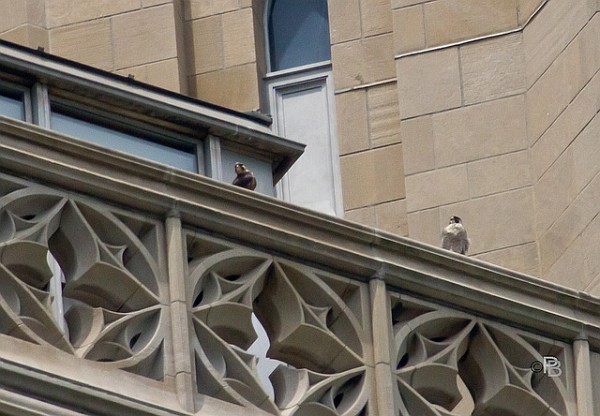
Yesterday I said I was taking a break from peregrines — but that was only on the blog. Spurred by surprisingly good weather I decided to make a driving tour of peregrine nest sites in Allegheny County. I wanted to know if the nestlings at each site had flown.
Here’s what I found.
Cathedral of Learning, University of Pittsburgh:
I started and ended my tour at Schenley Plaza watching Dorothy, E2 and their three youngsters.
My morning stop was very brief — only 10 minutes — but in that time I saw both parents and all three “kids.” Two were ledge-walking while the third waited on the green nest perch, seen via the web on my cellphone.
As I left Oakland I posted an update to Pittsburgh Falconuts. When I returned at 3:00pm I found an impromptu Fledge Watch in progress with John English, Peter Bell and Anne-Marie Bosnyak. We had been emailing/posting on the road all day, finally meeting up at the tent.
John and Peter said I’d missed Dorothy on the nestrail with her first ledge-walker (Peter Bell’s photo above) and some great flight demonstrations. Thankfully Dorothy and E2 kited again and flew loop-the-loops around the building. Wow!
As of last evening, none of the three nestlings had flown. Maybe one will fly today. Maybe tomorrow.
Downtown Pittsburgh:
They’re fledging!
As I suspected the youngsters at this nest are slightly older than the Pitt birds so they’re already making their first flights. When I arrived at 10:15am I saw Louie watching the nest site and one youngster at the nest opening. I could tell a fledgling was probably on a nearby roof because Louie was watching that roof and smaller birds were giving alarm calls. Unfortunately it was impossible to see the rooftop.
I posted an update and Anne-Marie swung by for a look. She was just going to drive through but stayed an hour because (as she wrote in email)…
Downtown peregrine fledged. Sitting on corner of [Point Park] academic hall. Mom or Dad visited juvie on bldg here. Saw one in a dive for food and then 2 turkey vultures came cruising by and D or L started screeching and flying about! Our juvie is conveniently perched so it can be viewed from Nathans where famished falcon watchers can get a bite to eat! ;-).
During the nesting season Dori and Louie’s site was a secret but now the chicks are out of the nest so I can show you where it is.
Here’s the nest site with an about-to-fledge youngster perched at the edge (red arrow). The site is a narrow air shaft at the back of a building between Smithfield and Wood Streets. It’s on the right as you drive down Third Avenue. The building is a data center so all the windows are bricked up.
Wouldn’t you know peregrines would choose a building where no one could look at them! (Click on the photo below for a wider view.)
The Downtown youngsters are in the vicinity of Point Park University so their parents watch from the top of Lawrence Hall. Here’s Louie perched at the roof peak yesterday morning. No sign of Dori. Maybe she was watching a fledgling perched elsewhere.
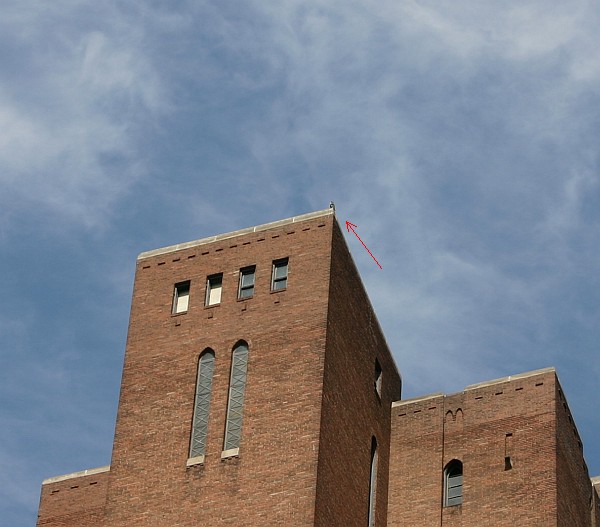
If you’re Downtown near Point Park University, keep looking up.
Tarentum Bridge:
Thanks to Rob Protz’ observations, the PA Game Commission was able to confirm Friday that peregrines nested on the Tarentum Bridge. Beth Fife reported two adults and one feathered juvenile close to fledging.
I drove to Tarentum in hopes of seeing the family in action. The peregrines favor the upriver side of the bridge between the left abutment and the New Kensington hillside so I went to the end of Tarentum’s Wood Street (another Wood Street!) and stood at the river’s edge.

Unfortunately the bridge is so far away that you really need a scope to see anything. I don’t have a scope but I did see an adult fly in and perch above the abutment.
If you’d like to see peregrines easily come to Pitt Peregrine Fledge Watch at the Schenley Plaza tent.
UPDATE: Thunderstorms are predicted from noon to 4:00pm so today’s watch will start at 11:00am and last until it rains or until 2:00pm — whichever comes first. Click here for the rest of the schedule or follow @KStJBirdlog on Twitter or Kate StJohn on Facebook for Fledge Watch updates.
(top photo by Peter Bell, remaining photos by Kate St. John)
Hackberry Emperor
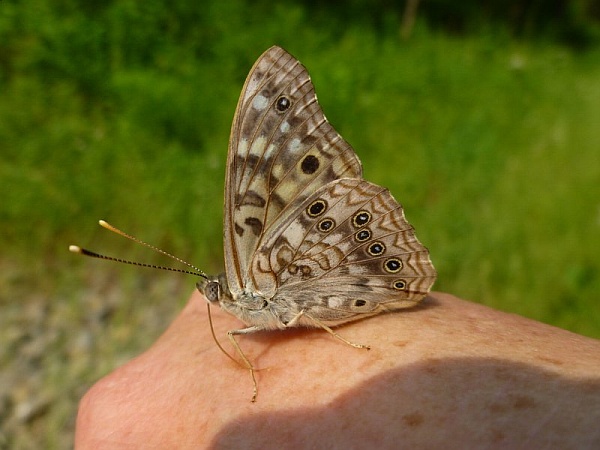
This morning I’m taking a break from peregrines to look at a butterfly found in southwestern Pennsylvania, though we don’t often notice him.
The Hackberry Emperor doesn’t stand out like a monarch butterfly because he’s not poisonous like they are. Instead he matches his habitat and flies quickly and erratically to outmaneuver the birds that want to eat him.
He is twice named for his favorite food. In the caterpillar stage the Hackberry Emperor (Asterocampa celtis) eats trees and shrubs in the hackberry (Celtis) genus.
Last winter I found many northern hackberry trees in Schenley Park so I’d expect to find these butterflies there, but they’re hiding. They rest upside down on tree trunks and look like bark.
The adults eat sap, dung, rotting fruit and carrion and will sip moisture where they find it.
On a hot day at Buck Run last weekend, this one sipped the sweat from Bob Machesney’s hand. Dianne took his picture.
(photo by Dianne Machesney)
On The Ledge, Soon To Fledge
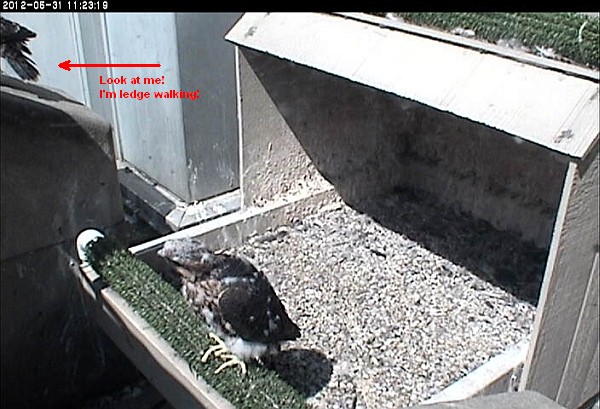
Last month, with history as my guide, I predicted that the first Pitt peregrine chick would fly on June 5 and the best days for Fledge Watch would be June 7 and 8.
But that was before I found out all three chicks are boys. (Male peregrines learn to fly earlier than their sisters.)
That was before one of the chicks fell into the gully on Sunday and returned on Tuesday, thereby exploring off-nest earlier than usual.
And that’s before they started showing their independence by acting selfish at mealtimes. Case in point…
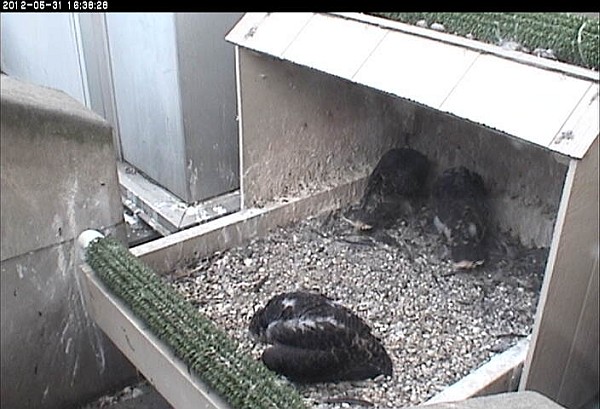
Have you seen how the chicks grab the prey from their parents and mantle over it? The near chick in the photo above is really worried someone will take his snack so he’s using his wings to hide it from his brothers. No more sitting in a row while Dorothy distributes the food. “I’m a big boy. I want to eat this alone!”
Yesterday morning the first chick ledge-walked up the bulwark (top photo) and in the afternoon one perched on the hood of the nestbox just like his mother does. (photo below)
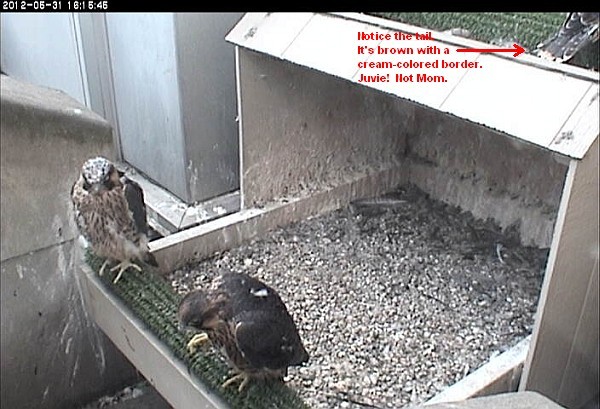
This is a sure sign they’ll fly soon. “Ledging” can lead to fledging in just two days.
I now predict with confidence that the first chick will fly soon, perhaps this weekend. My hunch is Sunday at the earliest because bad weather will keep them down until then. (I think!)
So despite the fact that I have other things to do this weekend I’m going to change my plans and start Fledge Watch on Sunday.
The new schedule is jogged earlier than the one I declared last month. Read the next blog post for details.
(photos from the National Aviary falconcam at Univ of Pittsburgh)
Pitt Peregrine Fledge Watch: REVISED SCHEDULE 2012

Dorothy and E2’s peregrine chicks are raring to go. They’re going to make their first flight next week — maybe as soon as Sunday — so I’ve changed the Fledge Watch schedule.
Come join me at the Schenley Plaza tent (shown above) for Pitt Peregrine Fledge Watch.
See the young peregrines walk on the ledges and exercise their wings. Watch Dorothy and E2 show their kids how to fly with some really cool flight demonstrations. Come learn about peregrines and swap stories about the nesting year, including news of Pitt peregrine alumni and the Downtown peregrines (!).
Here’s the revised schedule, weather permitting. Bad weather will change this plan, so watch the blog for updates.
- Sunday June 3, 1:00pm to 2:00pm. Showers and gusty winds are predicted. The chicks may lay low but I’m going to check anyway. If it’s raining this watch will be cancelled.
- Monday, June 4, noon to 1:30pm. Monday’s the first day of really good weather since the weekend. We ought to see a lot of activity today at lunchtime.
- Tuesday, June 5, 12:30pm to 1:30pm (and after work, 5:30pm to 7:00pm). The weather looks good for Tuesday. Somebody’s going to fly today.
- Wednesday, June 6, noon to 2:00pm. I’m staying longer at lunch on Wednesday because I think it’ll be a good day.
- Thursday, June 7, noon to 2:00pm (and after work, 5:30pm to 7:00pm). Activity on the ledge might be on the wane but I’m hoping for a good burst of flapping on Thursday. If they’ve all flown away from the nest area, this date will be a bust. Stay tuned.
- Friday, June 8, 1:00pm to 2:00pm (and after work, 5:30pm to 7:00pm). Soon I’ll be chasing the “kids” around campus instead of sitting at the tent. Today will be good to start at the tent.
- Saturday & Sunday, June 9 & 10, no time set. At this point the fledglings will probably be flying to other buildings. When they do I’ll be either at the tent or on campus circling the Cathedral of Learning and Heinz Chapel. Check the blog for news.
Plan on joining me at the tent for Pitt Peregrine Fledge Watch.
See these links (May 31, June 3, June 4) for news of last year’s fun and this Peregrine FAQ that describes what you’ll see on camera as the young peregrines leave the nest.
(photo of the Schenley Plaza tent by Kate St. John)
What’s Wrong With Mute Swans?
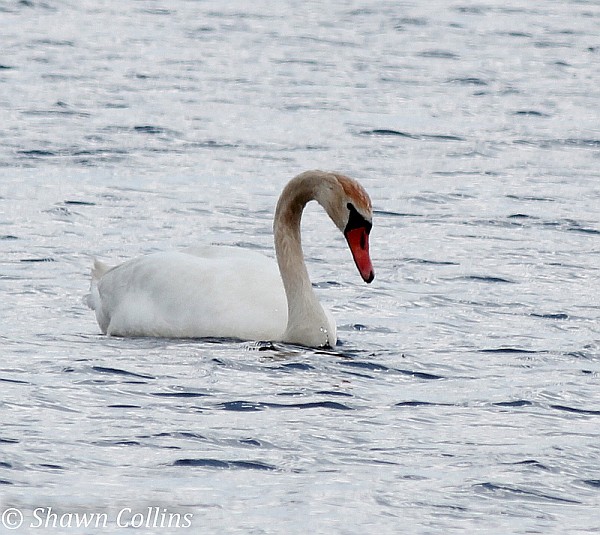
As you can tell by the question, mute swans are controversial.
These big, beautiful, white birds with knobbed orange bills are originally from Eurasia, imported to North America as living decorations for ornamental ponds. Their curved necks and stately demeanor brought their owners a touch of romance and hints of Tchaikovsky’s Swan Lake.
The imported birds were captive but their offspring were not. In the 1900’s mute swans became wildly successful and spread along the East Coast from Maine to South Carolina with smaller flocks in the Great Lakes and Pacific Northwest. That’s when the problems began.
Mute swans are very territorial. When defending their nesting and feeding areas they chase and peck any species that gets in their way, sometimes even humans. Because they’re so large and aggressive they rarely have to fight. Simply raising their wings (like this) can be enough. Mute swans win through intimidation.
The result is that native waterfowl are driven off their breeding grounds and the swans’ large appetites degrade the vegetative habitat. Both problems have contributed to native waterfowl declines.
In 2003 the mute swan’s burgeoning population, increasing 10% per year, led the US Fish and Wildlife Service to propose controlling them in the Atlantic Flyway. Swan lovers, like Save the Mute Swans in Connecticut, responded with local protection laws.
The controversy continues. Native waterfowl decline where mute swans thrive and Audubon chapters ask that the species be controlled.
Like Canada geese and white-tailed deer our society has artificially altered the mute swan’s population. We’ve made too much of a good thing and now we’re coping with the results.
For a good description of mute swans and the controversy surrounding them, see this Tails of Birding blog from 2008.
(photo by Shawn Collins)
